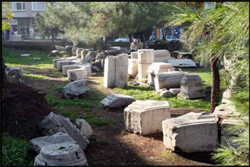
Thyatira, modern Akhisar, is located forty-two miles inland from the Aegean Sea in a long valley connecting the Hermus and Caicos Valleys. In the middle of the valley is a very slight rising piece of ground that became the acropolis of Thyatira. Its physical location was one of military weakness, not a city with a strong, impregnable fortress. Major excavations have never been done at Thyatira, so relatively little is known about the city.
Little is known about the early history of Thyratira, but the city grew in importance in the third century B.C. when Seleucus Nicanor refounded it. It was never a great city.
The city became a trading center. Blaiklock said, “More trade guilds, those ubiquitous ancient associations of businessmen and craftsmen, have been identified in Thyatira than in any other Asian city” (1983, 450). One will remember that Lydia, a seller of purple, was from the city of Thyatira (Acts 16:14). When she met Paul, she had traveled to the Macedonian city of Philippi to sell her wares. Thyatira was an important center of the wool trade. A guild of wool workers is mentioned in an inscription, and others name several dyers and fullers in and around Thyatira, as well as the neighboring cities of Laodicea, Hierapolis, and Colossae. Also an inscription from Thessalonica tells of a resident there from Thyatira, Menippus, who deals in purple dyes (Anchor Bible Dictionary, VI: 546).
Blaiklock comments on the danger these trade guilds posed to Christians saying,
The trade guilds must have been anxious problems to the Christian craftsman. He hardly could have attended the formal meetings and banquets without witnessing licentiousness and implicitly condoning pagan rites. It was the old Corinthian problem of “sitting at meat in the idol’s temple” which confronted the struggling church (1983, 450).
William Ramsay described the effect separation from those guilds might have: “To hold aloof from the clubs was to set oneself down as a mean-spirited, grudging, ill-conditioned person, hostile to existing society, devoid of generous impulse and kindly neighborly feeling, an enemy of mankind” (1909, 348).

“Prominent among the deities worshiped at Thyatira was Tyrimnos, who became identified with Apollo the sun-god, and Boreitene, a goddess identified with Artemis. It is possible that the references to the Son of God with ‘eyes like a flame of fire’ and feet ‘like burnished bronze’ are a conscious reference to the claims of the sun-god at Thyatira (Rev. 2:18)” (Interpreter’s Dictionary of the Bible, IV: 638).
Like the church at Smyrna, the church at Thyatira was affected by compromising teaching (Rev. 2:18-29). They tolerated a false teacher, a Jezebel, in their midst who was seducing the church’s members to commit fornication and to eat things sacrificed to idols.